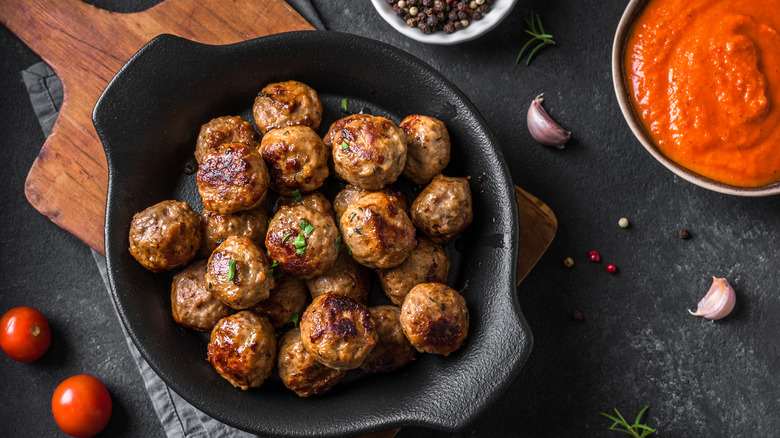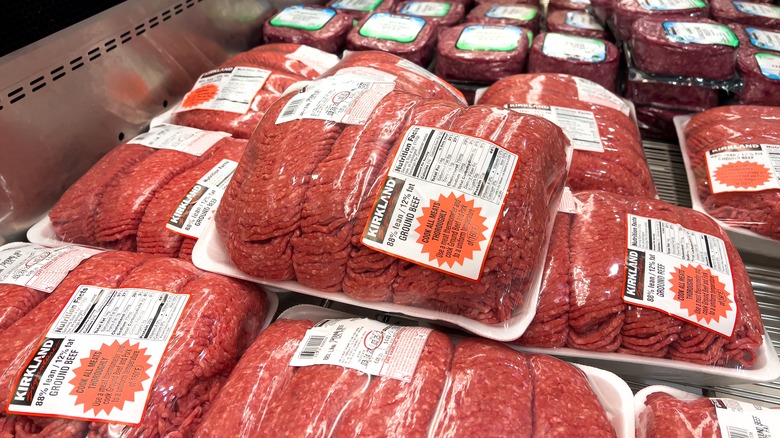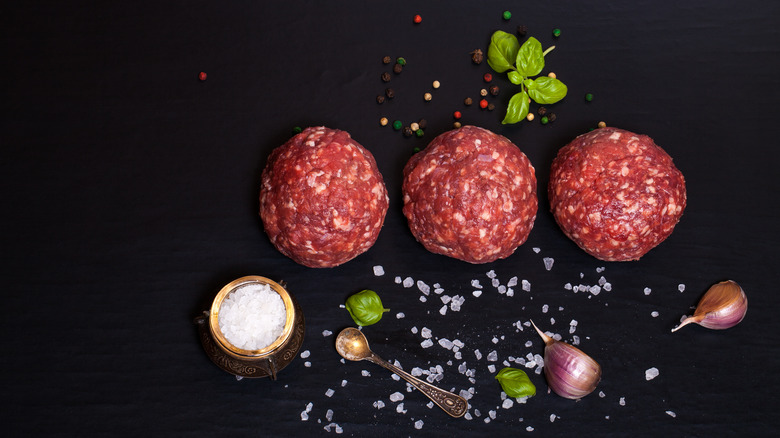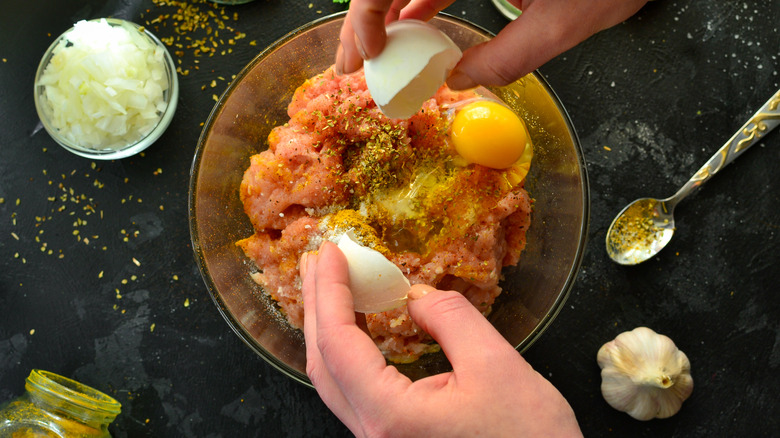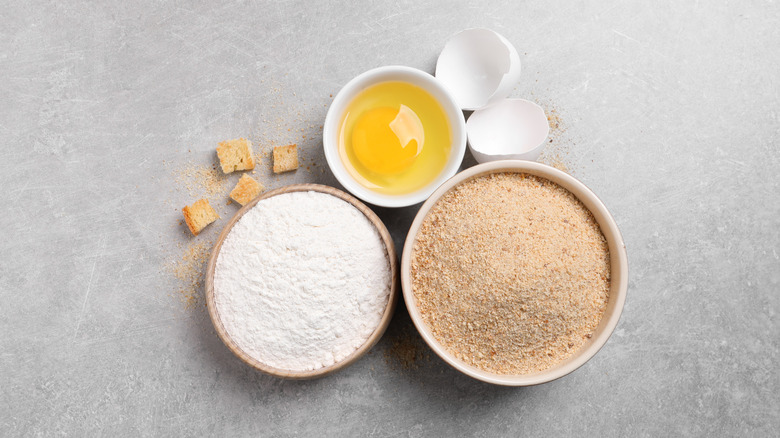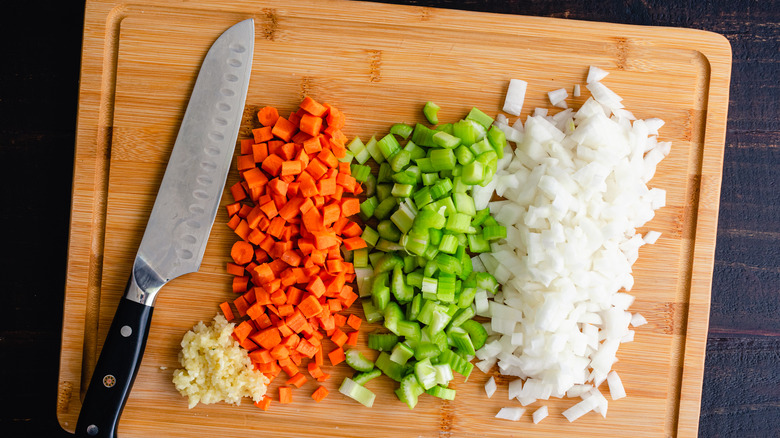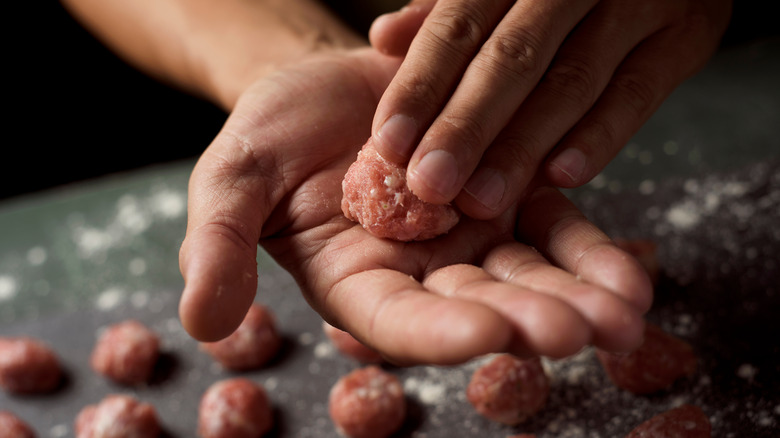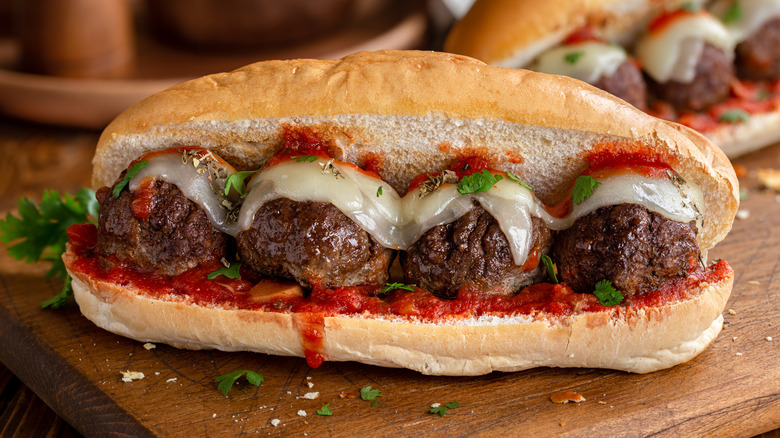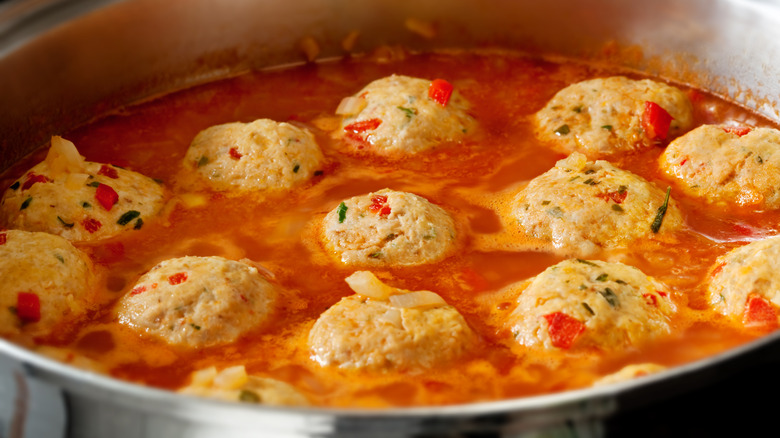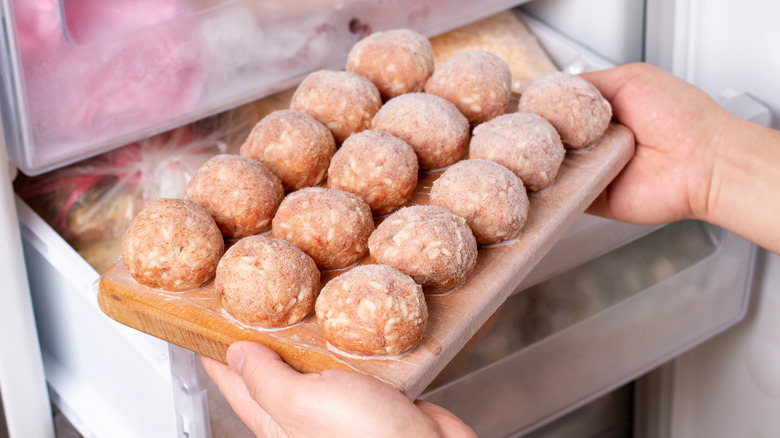Mistakes You Need To Avoid With Meatballs
Meatballs are one of the simplest foods to cook and have many different recipes from around the world. Many believe this dish originated in Italy, but the roots of the first meatballs were planted elsewhere and weren't made with ground beef. The first meatball recipe to be recorded in a cookbook was made by the Persians, who made them with ground lamb, according to The Atlantic. Meatballs became associated with Italy ever since the dish was transported to the country from the Middle East during the time of the Roman Empire. As Italian immigrants came to America at the beginning of the 20th century, meatballs became larger. Meatballs were often served with marinara sauce due to the regular amount of cash-crop tomatoes being grown at the time.
From the classic Italian meatballs to ones not made of meat at all (yes, that's possible), there's no such thing as an incorrect meatball recipe — just ways to cook and prepare them that might not be the most effective. You're probably wondering: How could anyone possibly mess up such a simple dish other than simple over or undercooking? You'd be surprised how many factors could dictate whether you make a good meatball or not. These simple tips will ensure that there's no room for error in the kitchen, so no matter how your own meatball recipe evolves over time, it'll be exactly how you like.
Using meat without enough fat
Fat is a component of meat that isn't the most nutritious for you (especially if eaten in large amounts). On another note, you can't make delicious meatballs if your meat is too lean. Keep an eye out for labeling on packaged meat at the store before purchasing. The first number is the percentage of lean meat, while the second number describes the percentage of fat. The best meat-to-fat ratio for homemade meatballs is 70/30 on average, which means the meat should comprise 70% lean meat and 30% fat.
One tip is to mix lean beef with other fattier meat. Pork is a good example because it has 40% fat and won't throw off the ratio by much since the meatballs will still comprise the majority of lean meat with less fat. If you want to avoid fat and gluten totally, another ingredient swap you should try next in your meatballs is to incorporate 100% lean beef with oats instead of bread crumbs. Meatballs without fat will not have as much moisture as those with a 70/30 ratio. Oats are a great solution for dry meatballs as the oats will absorb any liquid you include in your recipe — even eggs. The nutritional benefits of this method are a bonus as you won't be consuming fat and will have a lower calorie intake. However, the unique flavor of meatballs will not be present without fat. No sauce or seasoning you use will be able to replicate it.
Getting the seasoning wrong
If you make meatballs without seasoning them, you're just making beef burgers without the patty form. Spiceography notes some of the best spices to season meatballs include Italian parsley, oregano, and rosemary.
You can't make classic Italian meatballs without Italian parsley because its natural, slightly bitter taste makes the flavors of other ingredients pop. If you believe strong flavors are the most important quality in a meatball, don't forget oregano (it's also great to use in the sauce). Rosemary is the most versatile herb you can use to season meatballs. If you like the taste of sage and thyme but aren't a fan of oregano's strong spice, rosemary is your herb match from heaven. Red pepper flakes, garlic, and onions are also great ingredients to use for meatballs, as these additions provide spice and sharpness on several different layers.
Suppose you want to avoid using popular seasonings included in Italian meatballs. In that case, common additions may be cilantro, turmeric, cumin, and brown sugar, resulting in something like our Moroccan meatballs recipe.
Meatballs need strong flavors to succeed, but having too much of them will make them fail indefinitely. Since you've already included so many herbs and spices, there's no need to add anything more than a teaspoon of salt. You want to be able to taste the unique flavor of the meatball that's provided to you by the fats. Using too much salt will overshadow that taste, and the flavors will become unbalanced.
Using the wrong amount of eggs
Eggs are one of the best ingredients to bind meals, from the moment you wake up in the morning to cook breakfast to the end of the day when you're fixing to bake a sweet dessert. An egg is especially useful for meat products and meals because it forms gels that keep the meat confined together, according to the Incredible Egg. That said, eggs are a perfect binder for meatballs to help develop your desired shape. On the other hand, this isn't an invitation to use as many as you want. Cook's Illustrated explains that adding too many eggs will put your meatballs at risk of having a soggy texture. Any additional and unnecessary liquid will also cause difficulty mixing and forming meatballs. Adding a single egg should be enough to do the trick, with two being the maximum for each pound of meat you use. Adding more eggs than that will leave you with a mushy meatball mess.
If you're allergic to eggs, celebrity chef Michael Symon has a secret ingredient: ricotta cheese. Not only will your meatballs be just as soft as if you were using bread crumbs and eggs, but you can use ricotta cheese as a replacement so you won't have to miss out on eating the dish with the rest of your friends and family at dinner.
Using the wrong amount of bread crumbs (or flour)
Bread crumbs are another popular binder for meatballs that can become problematic if used incorrectly. Adding too many bread crumbs to the mix will cause your meatballs to become loose and fall apart. The same applies to flour. BBC Good Food notes that meatballs holding an overuse of breadcrumbs will have the consistency of turkey stuffing or dumpling filling. The purpose of using breadcrumbs (or flour) is to prevent meatballs from becoming unpleasantly dry by absorbing liquid ingredients and juices from the meat. You want to have a balance, not the opposite, of the initial issue by having meat that is too dry or lean.
Flour can be used as a decent binder, but it can be even more useful in a different part of the process. You can complete your meatballs first and then roll them around in flour before cooking. This is a great technique to use if you're nervous about your meatballs falling apart. If breadcrumbs and flour aren't giving you the results you want for your creations, try out Ree Drummond's secret for perfect meatballs; that same white Wonder Bread that sticks to your mouth when making sandwiches is a great binder for your next dinner.
Adding too many chopped vegetables
Chopped vegetables can add great flavor to meatballs just as much as herbs and spices. Chopped garlic and onion, in particular, are some of the best options as long as these alliums are kept in small quantities. Adding too many chopped vegetables will cause an inconvenience.
The purpose of using binders like eggs and breadcrumbs is to give meatballs a balance of textures. Meatballs, of course, need to be solid enough for chewing while having liquid and liquid-absorbent ingredients to prevent them from giving you jaw pain. Overusing vegetables will throw off that balance and keep all components from sticking to each other. You won't be able to make it to the cooking stage if your vegetables prevent your meat from forming into their recognizable shape. Using anything more than two portions of diced garlic or onions will most likely cause this problem.
If you can't find a way to include the vegetables you want to use for your meatballs, you always have the choice to either serve them as a side dish or you can reserve them for the sauce.
Overmixing your meatballs
Have you ever prepared and cooked meatballs that were too tough to chew? The way to avoid this issue is simple — stop overmixing your meatballs. You can make this easy mistake in multiple ways, but knowing what to look for will help you avoid it altogether.
The most common thing that leads to overmixed meatballs is forming the balls for an extended amount of time. Repeatedly handling the meat, and handling it roughly, will overwork the meatballs and make them dry. A technique known as "the claw" is a great method you can use at this point in the process. You would have to spread your fingers like a sloth's paw and insert them into the meat to tuck and lift it constantly. Keep performing this step until you feel the elements are mixed enough. If your meat resembles a sufficient ball and has everything it needs before cooking, don't second guess yourself because you could end up ruining a perfectly fine meatball.
Mixing the meat with your hands is an essential part of preparing meatballs because it's a great indicator of how blended the ingredients are. You'll miss out on this step if you use a food processor instead, leading to a higher risk of overmixed meatballs. A food processor should only join you in chopping vegetables or grinding the meat.
Rolling with dry hands
One thing that is less a mistake than a lack of technique is not rolling your meat into a ball form. That may seem like an obvious thing that everyone should instinctually know when cooking, but it's not as easy as it sounds — especially if you're trying a recipe for the first time or have never been taught the proper way to roll meat. So, don't be embarrassed if you've yet to roll meatballs successfully. It doesn't mean you're a bad cook — you're likely just making a small error.
Trying to roll meatballs while your hands are dry will make you want to rage quit. You won't get anywhere in the kitchen if the meat keeps sticking to your hands. Livestrong notes that handling meat with cold, wet hands is an effective solution. You should also wet your hands before making burger patties or any other recipe that requires you to work with ground beef. Olive oil is another great option as it creates an invisible wall between the meat and your hands. Make sure not to use too much olive oil because it's exceedingly slick and can cause the meat to slip right through your grasp (creating the exact opposite of the problem you're trying to avoid in the first place). Overall, dipping your hands in cold water or rubbing them with olive oil will prevent sticking and frustration.
Meatball size matters
Meatballs may take the same shape, but these joyful creations are not always the same size. The majority of meatballs you will find pre-packaged are one inch, with larger ones being two inches. South Florida's Sun Sentinel notes using different types of scoopers can help determine the size of the meatball you want to cook. Small meatballs (which should be ½ to ¾ of an inch) are best with a melon baller, while average-sized and large meatballs can be measured with an ice cream scooper.
Start small with your meatballs and go bigger if it matches your dish better. Smaller-sized meatballs are better served for appetizers. You don't want to eat too much before dinner or too little when you're aiming to have a complete meal. Medium meatballs are a perfect balance for your meatball sub, sandwiches, or Swedish-style dish. Medium (one-inch balls) won't be too large to fit between bread, nor be so small as to fall out of the bread you're serving them on. The best dish to serve large meatballs is spaghetti, where your creations can stand out in terms of appearance and provide a more effective amount of protein for your diet.
Make sure the meatballs are the same size if you make them all at once. Inconsistent sizes will lead to some meatballs becoming over or undercooked. Meatballs of any size should be cooked for 15 minutes on the stove or in the range of 20 to 30 minutes in the oven.
Forgetting to brown
When you're cooking your meatballs, and you notice the meat has begun to turn brown, you've reached a point in the cooking process called the Maillard reaction. The Maillard process is a chemical reaction that starts when a sugar and amino acid (responsible for protein production) has been heated. After undergoing this transformation, food such as meat or bread will have a different texture and taste, carmelizing to take on a new profile.
Browning isn't required to make meatballs. However, this technique is preferred because it can make the meatballs have a crispier crust and an improved flavor. You don't want to miss out on browning meatballs if those qualities sound appetizing to you. The best way to brown your meatballs is to do so in a pan. On another note, you can still accomplish this if you cook them in an oven, as long as you take some additional steps. Alton Brown uses a mini muffin tin to make meatballs when cooking in the oven, giving them great sear and texture. Additionally, the celebrity chef recommends covering the dents with breadcrumbs to seal juices and develop a crunchy exterior layer.
Simmering in the sauce for the wrong amount of time
After successfully forming and cooking the meatballs, you're ready for the final step — to let the meatballs simmer down in your chosen sauce. Nothing could ruin the dish at the last minute, right? Wrong. Homecook World explains meatballs can become overcooked if you allow them to simmer for too long. The overcooked meatballs will result in a tough texture and become soft and soggy over time as they absorb too much sauce and liquid.
Homemade meatballs are best cooked when simmering for 10 minutes at the minimum and 15 at the maximum. Frozen meatballs will need to cook longer than that because they need time to thaw, and we recommend separating them from the sauce first to drain off any added moisture released from the packaging. Heating for 30 minutes minimum and one-hour maximum should work. If you're simmering your meatballs within this time range and the final product still ends up overcooked, then you may have done your cooking at the wrong temperature. Any type of ground meat you use needs to reach 145 F at its center, so make sure this is the case for all your meatballs (via Minnesota Department of Health).
Storing in the refrigerator & freezer incorrectly
You've worked so hard to avoid making mistakes on your meatballs. If you don't want all of your hard work to go to waste, make sure you are storing them correctly. The U.S. Department of Agriculture notes that cooked ground beef meatballs will not survive in the refrigerator after three to four days. Certain germs present in the meat, like spoilage and pathogenic bacteria, tend to grow faster in colder temperatures.
Foodsafety.gov explains that, in general, raw ground meat will need to be used before two days have passed by if they're stored in a refrigerator (an effective route to take if you plan on cooking meatballs the next day). You can also store meat in a freezer for up to three to four months, which gives you more time to plan out when you want to prepare and cook your meatballs for dinner. Just make sure not to do the "out of sight, out of mind" method because time moves faster than you probably think it does. You will avoid getting ill if you avoid storing meatballs in your fridge and freezer for too long.
